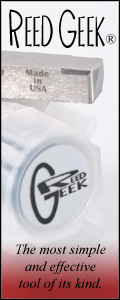Getting Started
So, you want to be a Saxophone player? Good for you! Do you have all ten fingers? Can you count to four? Most importantly, are you willing to spend the time it takes to learn to play an instrument? Great! You, too, can be a musician! The world needs more Saxophone players. It is everyone’s favorite instrument. Like the title of the page says, I am going to start at the beginning, so here goes.
First, get a good horn, at least one that works properly. Have it checked out by your local repair technician and make sure it is in good playing condition. Because the issue of which horn to start on has come up so frequently, I will address it here. It is my opinion that the beginner should start on either the alto or tenor, the alto being more popular. Starting on the soprano sax is not recommended because of the preciseness of the embouchure and skittishness of the horn in general. It is just plain hard to play! Like Larry Teal says in his book about the saxophone in general, it is easy to play,… badly! I would recommend that the beginning player play the alto or tenor for at least two years before taking on the soprano. Enough said on that subject. Some brand names of horns that I can recommend are Yamaha YAS-23 and Selmer AS 300 . Click here to buy Yamaha YAS 23, it’s the best student saxophone money can buy.
I have played a Keilwerth ST 90 student model alto and it was also very nice. Make sure you get everything with the horn: the mouthpiece, ligature, some reeds ( size 1-1/2 or 2). This strength of reed is fine for beginners. Do not buy into the common misconception that the harder strength of reed that you play on, the better you are. Most players use a medium strength reed and a medium size mouthpiece. Michael Brecker uses a #2 or #2 1/2! Using a reed that is too hard will lead to the very bad habit of biting. Check the neck strap to be sure it is fully adjustable. You should also have a cleaning cloth of some sort and some cork grease. Now you’re all set. Let’s go home and fire this puppy up!
The first thing you want to do after opening the case is to select a reed and get it wet. Ideally, the reed should be soaked in a cup of tepid (room temperature) water for several minutes. If you don’t have access to water then put the whole reed in your mouth and get it wet for about two or three minutes. Be careful not to bite it or damage the thin tip. During this time you should assemble the horn. Gently twist and push the neck piece into the body so that the neck is all the way in and pointing in a direction opposite of the bell, then tighten the screw on the neck. For more on reeds and how to prepare them, click here. I would suggest putting a little cork grease on the cork, and then put the mouthpiece on the neck by pushing and twisting at the same time. Then hold the horn in your lap with the mouthpiece pointing up in a direction so that you’re looking at it straight on. It’s a good idea to put the ligature on the mouthpiece first, that way you stand a better chance of not nicking your reed. Take the reed out of your mouth or cup of water and place it in between the ligature and the table of the mouthpiece. The flat side of the reed lies on the flat part of the mouthpiece. Take your time on this step, it’s crucial. The thin tip of the reed should be even with the tip of the mouthpiece. Press the reed against the tip of the mouthpiece to make sure it is adjusted correctly and centered properly. Then align the ligature so that it is centered and straight. Now tighten the screws, not too tight, just enough to keep the reed in place





